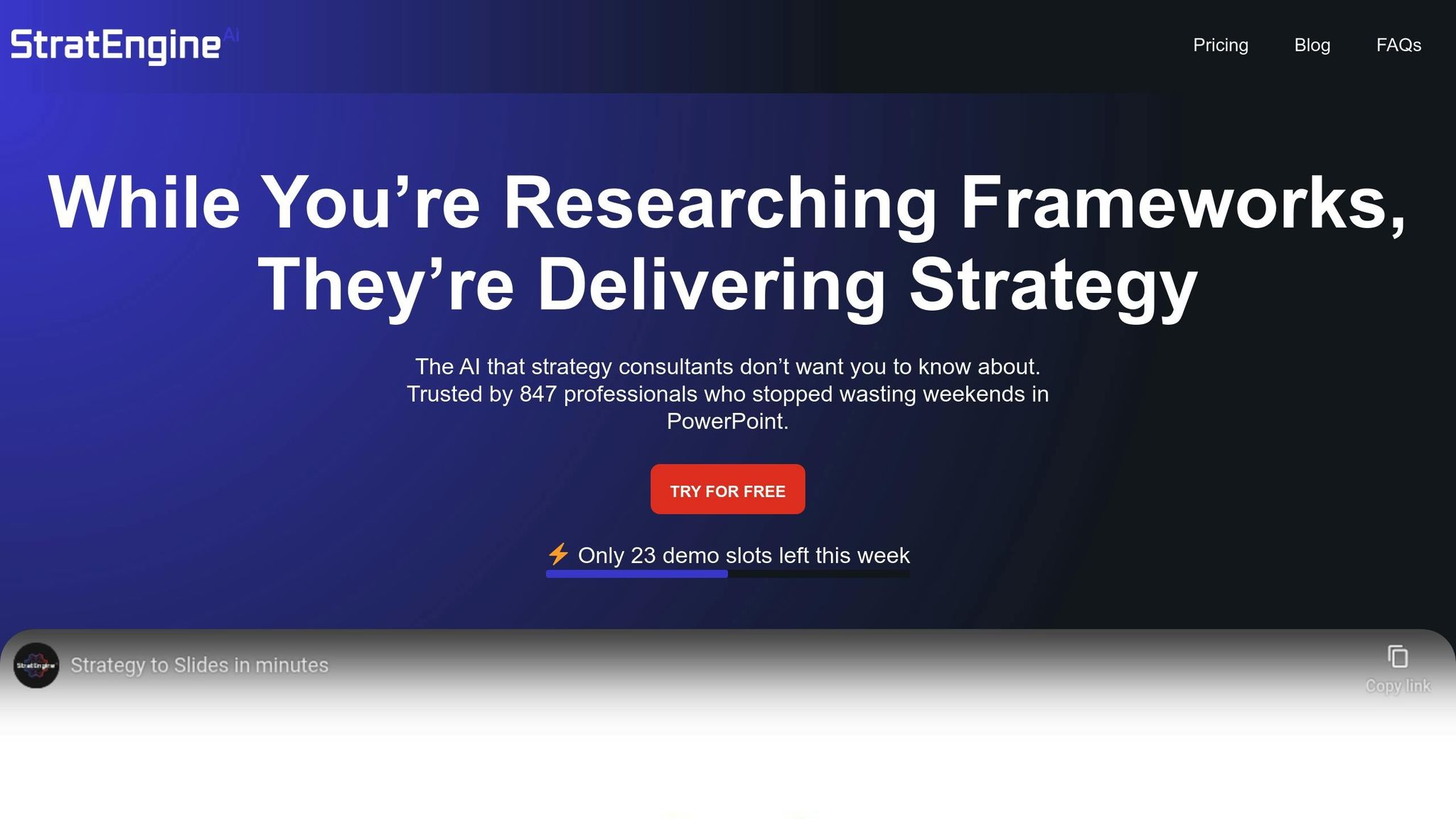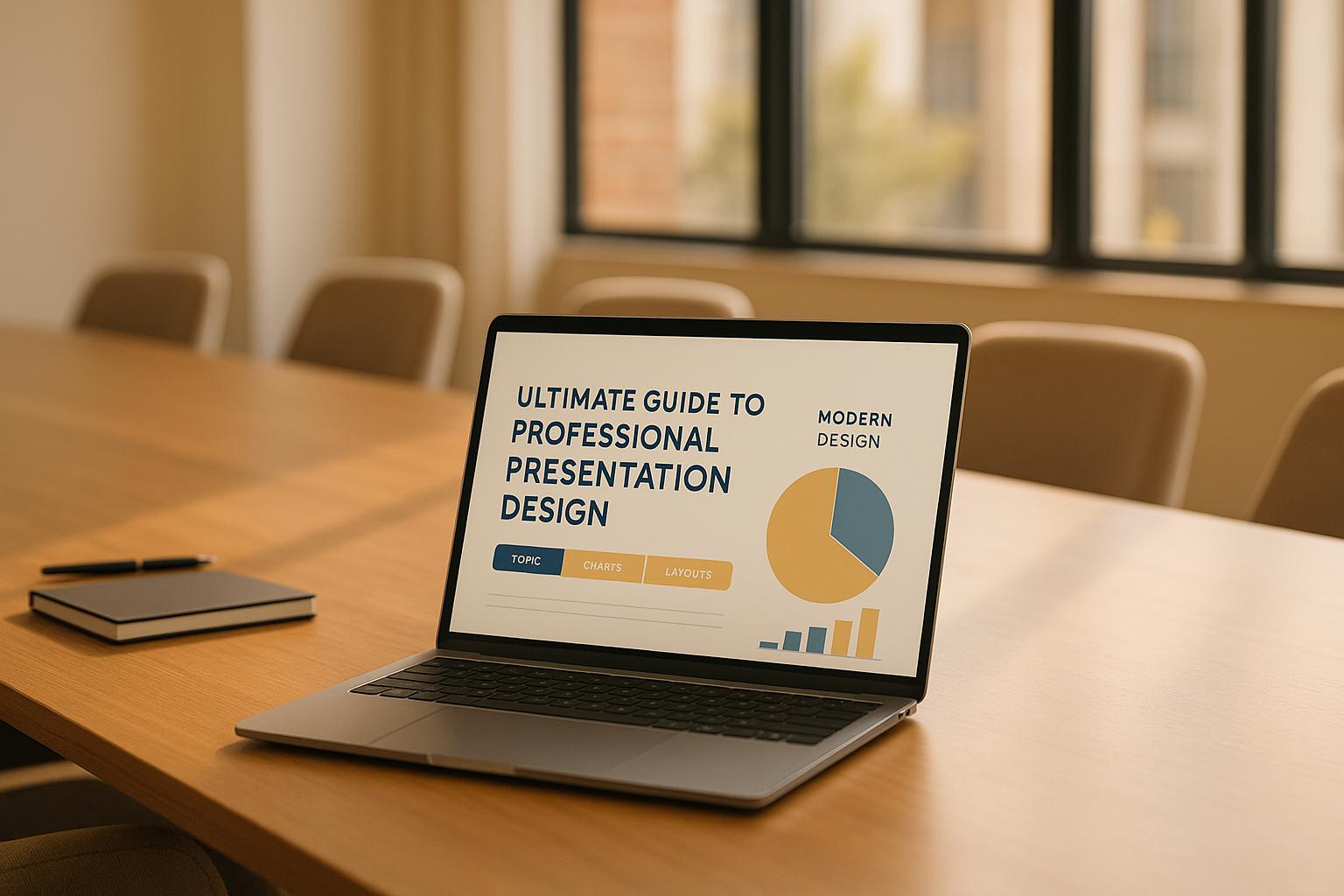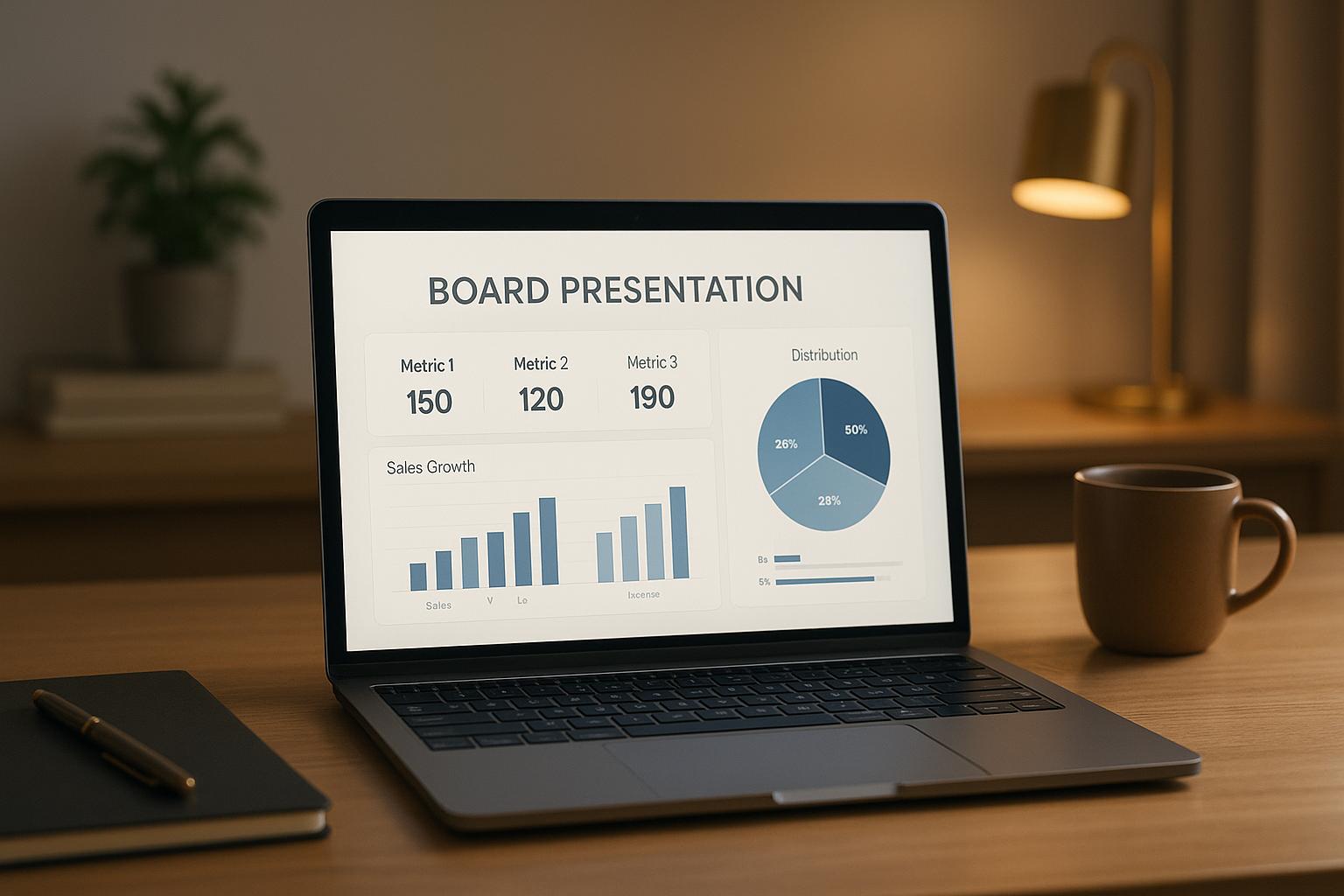In 2025, consulting has evolved dramatically with AI transforming how frameworks like OKRs, Porter's Five Forces, and Blue Ocean Strategy are applied. These AI-powered tools allow consultants to analyze data faster, make real-time adjustments, and deliver sharper insights. Here’s what you need to know:
- AI-Enhanced OKRs: Automates progress tracking, predicts risks, and adjusts goals dynamically, making it ideal for performance management and complex projects.
- Porter’s Five Forces with AI: Adds real-time market data and predictive analytics for deeper competitive analysis, perfect for market entry and positioning.
- Blue Ocean Strategy with AI: Identifies untapped opportunities by analyzing trends, customer feedback, and emerging needs, helping businesses create new markets.
- StratEngineAI: Combines multiple frameworks into one platform, automating strategy creation and execution, saving time while delivering actionable insights.
While AI speeds up processes and improves precision, it depends on accurate data and still requires human expertise for interpretation and decision-making. Consultants must balance AI's efficiency with their judgment to provide tailored, impactful recommendations.
1. OKRs with AI Support
Core Purpose
OKRs, or Objectives and Key Results, have become a cornerstone for aligning strategies and achieving measurable outcomes, especially for consultants working across diverse industries. By focusing on clear objectives paired with quantifiable results, OKRs help teams stay on track and aligned. This shift from periodic evaluations to continuous improvement is particularly valuable for consultants managing intricate projects with multiple stakeholders.
AI Integration
AI takes OKRs to the next level by introducing advanced capabilities. AI platforms can automatically pull real-time data from systems like ERP, CRM, and data warehouses, providing up-to-date insights[3].
One standout feature of AI is its predictive power. By analyzing performance trends, these systems can flag potential risks in key results well before they escalate into critical issues. For consultants, this means they can adjust strategies proactively rather than reactively. Additionally, AI can simulate various strategic scenarios, offering data-driven insights to guide decision-making with greater precision and confidence[1].
Another game-changer is dynamic OKR management. Traditional OKRs often struggle to keep up with shifting market conditions, but AI can adapt objectives in real time. By analyzing both external market trends and internal performance data, AI ensures that strategic goals remain relevant and actionable, even in rapidly changing environments[3][4].
Use Cases
The practical benefits of AI-supported OKRs are evident in several scenarios.
One common application is in digital transformation projects. Consultants use AI-enhanced OKRs to align cross-functional teams and monitor complex metrics like system performance, user engagement, and adoption rates. AI’s ability to identify bottlenecks in real time allows for smarter resource allocation, keeping these initiatives on track[1][2].
Operational efficiency efforts also see major advantages. AI can simultaneously monitor multiple performance indicators, such as cost reduction targets and process improvement metrics. This holistic view helps consultants uncover interconnected challenges that traditional methods might overlook.
For market expansion strategies, AI-supported OKRs prove invaluable. The framework enables tracking of key metrics like market penetration, competitive positioning, and customer acquisition costs, helping consultants fine-tune their strategies for growth.
Strengths and Limitations
The strengths of AI-driven OKRs are clear. They enable better data-driven decisions and real-time performance tracking, which many consultants report leads to improved efficiency and client satisfaction. The ability to quickly spot risks and optimize resources often results in better project outcomes and stronger client relationships[3][1][2].
However, these systems are not without challenges. High-quality data is essential for AI to function effectively, and poor data can lead to inaccurate insights. Integrating AI with existing systems can also be a complex and costly process, requiring significant investment in both technology and training[1].
Another concern is over-reliance on AI. While AI provides valuable insights, human expertise is still critical for interpreting results and making strategic decisions. Consultants must ensure that AI-generated insights are transparent and easy to explain to maintain trust with clients and stakeholders[1].
Lastly, change management is a hurdle. Teams and clients accustomed to traditional methods may resist adopting AI-powered processes. Successful implementation hinges on clear communication about the benefits and a thoughtful approach to managing this transition. By addressing these challenges, consultants can harness AI to deliver sharper, more timely insights and drive impactful results.
2. Porter's Five Forces with Real-Time AI Market Data
Core Purpose
Porter's Five Forces is a well-established framework used to analyze competitive landscapes and industry dynamics. It examines five key forces that shape competition: the threat of new entrants, the bargaining power of suppliers, the bargaining power of buyers, the threat of substitute products, and the intensity of rivalry among existing competitors. For consultants, it offers a structured way to evaluate market positioning and uncover strategic opportunities.
Traditionally, one limitation of this model has been its static nature, which can make it challenging to deliver timely insights. This is where AI steps in, transforming the framework into a dynamic tool capable of providing real-time analysis.
AI Integration
AI breathes new life into Porter's Five Forces by integrating continuous data feeds, much like its impact on OKRs. By monitoring competitor pricing, supplier metrics, customer sentiment, and regulatory changes, AI turns this static model into a real-time powerhouse.
One game-changing feature is automated data collection. AI systems can track competitor activities across multiple channels, analyzing everything from patent filings and hiring trends to social media sentiment and financial performance. This level of monitoring delivers insights that would be nearly impossible to gather manually.
Beyond data collection, predictive analytics adds another dimension. By identifying patterns in market data, AI can flag emerging threats before they fully materialize. For instance, it might detect signs of a new competitor entering the market by analyzing venture capital investments, regulatory filings, or patent activity in related sectors.
AI also makes it possible to analyze shifts in supplier and buyer power in real time. By processing vast amounts of transaction data, contract details, and pricing trends, consultants can identify changes in bargaining power as they occur, rather than weeks or months later through traditional research.
Use Cases
AI-enhanced Porter's Five Forces has practical applications across various industries:
- Technology consulting: Consultants advising software companies can use AI to track app store rankings, developer activity, and platform policy changes. This real-time data helps identify when major players are entering new markets or when regulatory shifts lower barriers to entry.
- Healthcare analysis: AI can monitor FDA approvals, patent expirations, and clinical trial outcomes in the pharmaceutical sector. This allows consultants to spot threats from generic drug manufacturers or opportunities arising from regulatory changes.
- Retail and e-commerce consulting: AI enables the tracking of competitor pricing strategies, inventory levels, and customer acquisition costs. This comprehensive view helps consultants identify market gaps and recommend optimal strategies for positioning.
- Financial services consulting: AI-powered analysis tracks fintech innovations, regulatory compliance costs, and customer behavior shifts. It can reveal when technological advances or regulatory changes are eroding traditional barriers to entry.
Strengths and Limitations
The biggest strength of AI-enhanced Porter's Five Forces is its real-time insights and comprehensive scope. Consultants can deliver up-to-date market intelligence, offering a more accurate view of industry dynamics compared to traditional methods. By processing data from multiple sources, AI provides a richer, more detailed analysis.
Another advantage is cost efficiency. AI systems can monitor hundreds of competitors and market indicators simultaneously, reducing the need for time-intensive manual research. This allows consultants to offer deeper insights while keeping their services competitively priced.
However, there are limitations to consider. Data quality and interpretation remain challenges. AI is only as reliable as the data it processes, and incomplete or biased information can lead to flawed conclusions. Additionally, market dynamics often involve subtleties that require human judgment to interpret effectively.
The complexity of AI systems can also pose transparency issues. Clients may find it difficult to understand how AI reaches its conclusions, which can make it harder for consultants to build trust and secure buy-in for their recommendations. To address this, consultants must pair AI insights with clear, human explanations, ensuring that their expertise remains central to the decision-making process.
3. Blue Ocean Strategy with AI-Powered Opportunity Detection
Core Purpose
The Blue Ocean Strategy is all about carving out new, uncontested market spaces instead of battling competitors in existing ones. By focusing on creating new markets, companies can sidestep direct competition entirely. This approach helps consultants pinpoint opportunities where businesses can deliver unique value propositions that make traditional competition irrelevant. The process involves reevaluating industry norms and determining which factors to eliminate, reduce, raise, or reinvent.
Traditionally, identifying these opportunities required time-consuming research and often overlooked emerging trends. Today, AI has stepped in to dramatically speed up and refine this process, uncovering untapped opportunities with remarkable efficiency.
AI Integration
AI has redefined how the Blue Ocean Strategy operates by automating the discovery of opportunities across vast and varied data sources. It can sift through customer complaints, social media content, patent filings, and market research, uncovering unmet needs and emerging trends that might go unnoticed by human researchers.
One of AI's key strengths is its ability to spot connections between seemingly unrelated industries. For instance, it might detect that customers in one sector are grappling with challenges similar to those in another, opening the door to cross-industry innovation.
AI also excels at sentiment analysis, processing millions of customer reviews, social media posts, and support tickets to highlight recurring frustrations with existing solutions. These insights reveal what customers truly value - often exposing gaps between customer expectations and what companies currently offer. These gaps frequently represent prime opportunities for creating new markets.
Through predictive modeling, AI can anticipate how factors like emerging technologies, demographic shifts, or regulatory changes might shape future market landscapes. By simulating various scenarios, AI helps identify the most promising paths for sustainable competitive advantage.
Use Cases
Consultants across a range of industries are already harnessing AI to supercharge their Blue Ocean Strategy efforts. Here are a few examples:
- Healthcare technology consulting: AI can analyze patient feedback, medical research, and regulatory developments to identify unmet needs in healthcare delivery. For example, AI might reveal that elderly patients struggle to manage medications for multiple conditions, pointing to opportunities for integrated digital health solutions that traditional providers have overlooked.
- Financial services consulting: By analyzing transaction data, customer service interactions, and demographic trends, AI can uncover gaps in financial services. It might identify underserved segments, such as gig workers in need of micro-investment platforms or automated savings tools tailored to specific life stages.
- Retail and consumer goods consulting: AI can track emerging lifestyle trends and consumption patterns through social media, purchase data, and broader societal shifts. This could lead to opportunities for products like sustainable alternatives to everyday items or solutions designed for remote workers.
- Manufacturing consulting: AI helps identify inefficiencies in industrial processes and supply chain management. By analyzing operational data and customer requirements, it can suggest new service models or product configurations that balance cost, quality, and speed in innovative ways.
Strengths and Limitations
The greatest strength of AI-enhanced Blue Ocean Strategy lies in its ability to scan markets comprehensively. AI can process massive amounts of data - from global patent filings to multilingual social media chatter and real-time industry trends - offering insights that would be impossible to gather manually. This broad scope significantly boosts the chances of uncovering truly novel market opportunities.
Speed and efficiency are also game-changers. Tasks that once took consulting teams months can now be completed in weeks. This faster turnaround allows for deeper exploration of multiple potential market spaces within standard project timelines, making the process more dynamic and iterative.
However, AI is not without its limitations. While it excels at data analysis, it cannot replace the creative leaps that often lead to breakthrough strategies. The most impactful market-creating moves often rely on human intuition and imagination, which go beyond what data can reveal.
Another challenge is contextual understanding. AI might highlight statistical patterns that suggest opportunities, but it can miss critical nuances like cultural factors, regulatory constraints, or competitive dynamics that could make those opportunities less viable. Human expertise is essential to interpret and validate AI-driven insights.
Finally, data bias can be a significant hurdle. If AI systems are trained on biased data that reflects existing market assumptions, they may struggle to identify disruptive opportunities that challenge industry norms. Consultants must stay alert to these biases and ensure that AI insights are complemented by independent, strategic thinking.
4. StratEngineAI

Core Purpose
StratEngineAI takes strategic planning to the next level by automating the entire process. This AI-driven platform redefines how strategies are crafted in 2025, removing the need for manual data collection and turning complex challenges into strategic briefs enriched with market insights, intelligence, and actionable plans.
What makes StratEngineAI stand out is its emphasis on execution and measurable results. Unlike traditional frameworks that often stop at the planning stage, StratEngineAI bridges the gap between strategy creation and implementation. This is a game-changer in an industry where, despite heavy investments in AI, only 1% of companies achieve AI maturity - a failure often tied to poor execution of strategic initiatives[5]. By integrating planning with execution, StratEngineAI addresses this critical issue head-on.
The platform offers access to over 20 established strategic frameworks, such as SWOT, Porter's Five Forces, and Blue Ocean Strategy. These frameworks act as building blocks, enabling consultants to craft multi-faceted strategies while maintaining the depth and precision expected by C-suite executives.
AI Integration
StratEngineAI uses cutting-edge natural language processing and predictive modeling to deliver real-time market insights and continuously update its recommendations. Its machine learning algorithms process live data feeds, ensuring strategies remain relevant as new information becomes available.
Key features include automated benchmarking, which compares client performance against industry standards, and sentiment analysis, which mines customer feedback and social media data for actionable insights.
One standout feature is the platform's generative AI capability, which creates polished, boardroom-ready presentations. What used to take consulting teams weeks - assembling market research, competitive analysis, and strategic recommendations - can now be done in minutes, all while maintaining the rigor expected in high-stakes consulting.
Additionally, StratEngineAI includes robust AI governance and compliance tools. These features ensure ethical and regulatory considerations are met, with explainability tools that help consultants understand and clearly communicate how recommendations are generated[3][4].
Use Cases
StratEngineAI is versatile, offering solutions across various strategic needs:
- Market Entry Strategy: By analyzing vast amounts of data, including competitor filings, economic trends, and social media sentiment, StratEngineAI identifies the best opportunities for expansion. For instance, a retail consulting project used the platform to pinpoint underserved regions and predict demand shifts, achieving a 15% faster market entry and a 10% higher ROI compared to traditional methods[1].
- M&A Due Diligence: The platform streamlines risk assessment and synergy analysis by processing financial statements, regulatory filings, and market research simultaneously. This approach helps uncover potential deal-breakers and value-creation opportunities that manual methods might overlook.
- ESG Strategy Development: StratEngineAI uses AI-driven sustainability metrics to monitor regulatory updates and benchmark client performance. Manufacturing consultants, for example, can model cost-saving scenarios while maintaining operational efficiency.
- Strategic Roadmap Creation: With dynamic KPI tracking and automated adjustment recommendations, the platform ensures strategies remain actionable and relevant, even as market conditions evolve. This addresses the common issue of strategies becoming outdated shortly after their creation.
Strengths and Limitations
StratEngineAI excels in delivering fast, comprehensive analysis. It processes data from diverse sources - financial statements, market research, social media analytics, and regulatory filings - producing evidence-based recommendations far quicker than traditional methods. This efficiency allows consultants to explore multiple scenarios within typical project timelines.
Its scalability makes it suitable for both large enterprises and small businesses, with flexible partnership models and pricing tied to measurable business outcomes. Clients typically see a 10-25% improvement in business performance through value-based engagements[5].
Another major advantage is real-time adaptability. Unlike static frameworks that require manual updates, StratEngineAI dynamically adjusts its recommendations as new data emerges. This is particularly valuable in fast-paced industries where outdated assumptions can derail strategies.
However, the platform does come with some limitations. Its effectiveness depends heavily on data quality - poor or incomplete data can lead to flawed recommendations. Ensuring reliable outputs requires strong data governance practices.
There’s also a learning curve. While StratEngineAI automates many processes, consultants need training to fully utilize its advanced features and interpret its insights. Integrating the platform with existing client systems may also pose technical challenges, requiring careful planning and support.
Finally, while StratEngineAI excels at data analysis and pattern recognition, human judgment remains irreplaceable. Contextual understanding and creative thinking are essential to complement the platform’s analytical capabilities. The best outcomes arise when StratEngineAI’s power is paired with the expertise and intuition of seasoned consultants.
sbb-itb-7250072
Principles of AI Strategy: 3 Frameworks Every Executive Needs to 10× ROI & Slash Timelines
Pros and Cons
After diving into how AI enhances various strategic frameworks, let’s break down the key strengths and limitations. The table below highlights the main advantages, challenges, and AI integration levels for each framework:
| Framework | Core Strengths | Key Limitations | Best Use Cases | AI Integration Level |
|---|---|---|---|---|
| OKRs with AI Support | Real-time progress tracking, automated alignment checks, and predictive analytics | Requires strong goal-setting culture, can become overly metric-focused, and needs consistent data input | Performance management, organizational alignment, and regular planning cycles | High – continuous monitoring and adjustment |
| Porter's Five Forces with Real-Time Data | Comprehensive competitive analysis, live market intelligence, and dynamic threat assessment | Complex data interpretation, potential for information overload, and requires industry-specific expertise | Market entry decisions, competitive positioning, and industry analysis | Medium – enhanced data collection and analysis |
| Blue Ocean Strategy with AI Opportunity Detection | Identifies untapped markets, reduces competitive pressure, and uncovers innovation opportunities | High execution risk, market validation challenges, and may require investment | New product development, market expansion, and disruptive innovation | High – pattern recognition and opportunity mapping |
| StratEngineAI | End-to-end automation, instant presentation generation, and multiple framework integration | Dependent on data quality, involves a learning curve, and requires human oversight for context | Comprehensive strategic planning, rapid strategy development, and boardroom presentations | Very High – full process automation |
These comparisons help consultants determine the best framework for their clients' unique needs. AI integration undeniably speeds up the analysis process, turning what once took weeks into minutes. However, this speed comes with a trade-off: AI may miss subtle complexities that seasoned consultants could uncover through deeper, more deliberate methods.
AI thrives on accurate, high-quality data. Without it, the results can mislead decision-making. This challenge is particularly relevant for consultants working with smaller businesses that may lack robust data systems. For example, OKRs with AI support automate tracking and analysis but still depend on human expertise for setting meaningful goals. On the other hand, StratEngineAI automates much of the workload but requires consultants to interpret results and provide strategic context.
Cost and complexity also vary. Porter’s Five Forces with AI requires an upfront investment, making it better suited for larger clients or industries with abundant data. In contrast, OKRs with AI offer simpler, streamlined tracking that’s more accessible for smaller businesses.
Additionally, consultants must adapt their approach to client preferences. Many executives value AI-generated insights when paired with traditional analysis. However, industries like healthcare and financial services may hesitate to fully automate decision-making due to strict compliance requirements. This means consultants must balance AI's efficiency with the need for regulatory oversight and human judgment.
Large organizations often gain the most from AI's sophisticated capabilities, while smaller businesses may benefit from simpler, less data-intensive solutions. By understanding these trade-offs, consultants can align the right framework with their clients' specific challenges, ensuring smarter and more tailored decision-making.
Conclusion
By 2025, AI-powered frameworks have become a cornerstone in strategic consulting. Tools like AI-enhanced OKRs are particularly effective for maintaining organizational focus and tracking performance in real-time, making them a go-to for consultants working with fast-growing companies. Meanwhile, Porter’s Five Forces integrated with real-time market data turns competitive analysis into a dynamic process, offering valuable insights for market entry and positioning. Similarly, Blue Ocean Strategy with AI-driven opportunity detection identifies untapped markets that might otherwise go unnoticed, though these findings still require thorough validation and careful execution.
For consultants looking to streamline their processes, StratEngineAI stands out as a game-changer. This platform integrates multiple frameworks into one cohesive tool, cutting down weeks of planning into mere minutes while maintaining depth and precision. Its ability to produce complete strategic briefs and presentation-ready materials directly addresses the time crunch consultants face in today’s fast-paced environment, making it easier to deliver tailored solutions for clients.
The key to leveraging these advancements lies in adapting the complexity of frameworks to fit client needs. Smaller businesses might benefit from simplified, AI-enhanced OKRs, while larger enterprises can take advantage of more robust platforms. However, sectors with strict regulations will still require significant human oversight. Data quality remains a critical factor - strong data collection paired with human judgment is essential for turning AI insights into actionable strategies.
Ultimately, the consulting firms that succeed in 2025 will be those that skillfully combine AI-driven efficiency with human expertise. By using these frameworks to automate repetitive tasks, consultants can focus on delivering creative, high-value strategic solutions that truly make a difference.
FAQs
What steps should consultants take to ensure high-quality data for AI-driven strategy frameworks?
To maintain top-notch data for AI-driven strategy frameworks, consultants need to prioritize setting up well-defined data governance standards. Regularly reviewing and refining data is equally important to ensure it stays accurate and consistent. AI tools can play a big role here - helping to spot trends, automate quality checks, and flag any inconsistencies, all of which boost data dependability.
It's also crucial to involve a mix of stakeholders in the process. Their input can help shape a structured data quality plan that aligns perfectly with strategic objectives. By focusing on these efforts, consultants can strengthen the reliability of AI frameworks and support smarter, more effective decision-making.
What challenges do consultants face when using AI to enhance traditional strategy frameworks like OKRs or Porter's Five Forces?
Consultants often encounter hurdles when incorporating AI into traditional strategy frameworks. A significant challenge lies in the intricate task of linking AI tools with diverse technologies and data sources. This process demands precise technical coordination and smooth integration. Without these elements, it becomes tough to unlock the full potential of frameworks enhanced by AI.
Another major obstacle is resistance to change within organizations. The introduction of AI can disrupt established workflows and upset existing hierarchies, sparking pushback from teams or leadership. Addressing this requires a thoughtful approach: clear communication, well-planned change management strategies, and a strong emphasis on aligning AI initiatives with the company’s overarching business objectives.
How does AI enhance opportunity detection in Blue Ocean Strategy, and what challenges might arise?
AI plays a powerful role in identifying opportunities within the framework of Blue Ocean Strategy. By processing massive datasets, it can reveal untapped market spaces, highlight potential non-customers, and simplify the process of value innovation. This means consultants can identify opportunities with greater speed and precision compared to traditional methods, making strategic planning more efficient and grounded in data.
That said, AI isn't without its limitations. It often struggles to redefine industry boundaries or grasp the subtleties of human behavior - elements that are crucial for driving innovation. Relying too heavily on AI insights can also stifle creativity or miss broader market trends that require human intuition. The real key lies in blending AI's analytical power with human expertise to fully maximize its potential in strategic planning.


